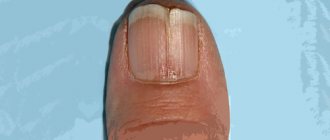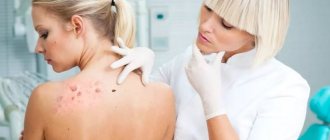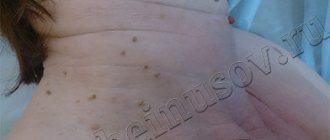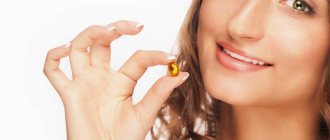Nail fungus or onychomycosis is an infectious contagious disease caused by microscopic pathogenic fungi. It occurs 5 times less often in children than in adults. However, if changes appear on the child’s nail plate, this diagnosis cannot be excluded. It accounts for 15% of cases of all nail pathologies in children. Over the past few years, there has been a tendency in pediatrics to increase the incidence of onychomycosis.
Types of fungal infections
Fungal infections can appear at any age. Infants most often encounter this problem - redness and peeling appear. The symptoms are similar to those of an allergic reaction, so therapy is often carried out, which is ineffective.
The clinical picture depends on the type of disease:
- Because Candida thrives in moist and warm environments, it multiplies in the diaper area of babies. This manifests as intense, large-scale redness with scaly edges.
- Oral thrush is characterized by the appearance of a tight, gray-whitish film in the cheeks and throat. This type of disease is also caused by Candida and is most common among infants.
- Ringworm is accompanied by severe itching, the appearance of round bald spots and blackheads. There is excessive hair fragility, which results in bald spots.
- Vaginal (genital) candidiasis also occurs in childhood, although much less frequently. The victims may be babies in the first weeks of life, whose mother gave them Candida at birth. Babies still have their mother's female sex hormones (estrogens) in their bodies. They appear to inhibit the regenerative ability of the mucous membranes, which in turn contributes to the progression of the disease.
Pet-borne dermatophytes should not be underestimated. The head and torso are affected. The main carriers are cats, as well as guinea pigs and rabbits. Accompanied by severe itching, redness and excessive dryness.
Table - Classification of mycosis pathogens
| Pathogen name | Localization area | How it manifests itself |
| Tinea capitis or Microsporum (microsporia or “ringworm”) | Scalp | Ring-shaped, sharply limited red spots appear, in which the hair either breaks or falls out. Sometimes the scalp starts to ooze due to weeping. Small red pustules may appear. |
| Tinea corporis (dermatophytosis) | Torso and upper limbs | It appears as pale red areas with characteristic peeling. In addition, there is unbearable itching. Therefore, it is important to start treatment as soon as possible to avoid spreading the fungus to other parts of the child’s body through scratching. |
| Tinea pedis (onychomycosis) | Nail plates | The filamentous fungus damages the toes or nails and gives them a characteristic yellowish coloration. The plates with onychomycosis become thick and brittle, with a “loose” structure. With the exception of visual changes, symptoms such as itching do not appear, so onychomycosis is usually diagnosed in the later stages of progression. |
Onychodystrophy as a sign of other diseases
A much more serious problem than isolated onychodystrophies are those that arise as a result of the development of other disorders in the functioning of the body. In such situations, patients require comprehensive treatment aimed at eliminating existing diseases and improving nail nutrition.
Onychorrhexis
Onychorrhexis is onychodystrophy, accompanied by longitudinal separation of the nail plate in any part of it, including at the base of the nail. Such changes may signal the development of chronic dermatosis, most often caused by frequent contact with specific chemicals.
Scleronychia
Scleronychia is a clear manifestation of endocrine diseases, i.e. hormonal imbalances as a result of excessive or, conversely, insufficient function of one or another endocrine gland. This type of onychodystrophy is characterized by a change in the color of the nail to yellow-brown, but unlike hyperpigmentation, this is accompanied by its thickening, loss of elasticity and transparency. Subsequently, the nail may separate in places from the nail bed, as with onycholysis. Sometimes the lunula disappears.
Trachyonychia
Trachyonychia is an uncommon type of onychodystrophy, characteristic of immunodeficiency states. It is characterized by paleness of the nail plate, loss of natural shine and the formation of small scales on it. The lunula has also disappeared.
Thimble-shaped nails
This form of the disease is characterized by the formation of small depressed dots on the surface of the nail, as if from a needle. This can happen when:
- psoriasis;
- lichen planus;
- exfoliative dermatitis;
- alopecia areata.
Reasons for the development of mycosis
Predisposing factors include taking antibiotics, poor hygiene when visiting swimming pools, increased sweating and/or poor immune system protection. In most cases, pathological disorders in the body occur due to a combination of reasons.
Varieties of opportunistic microorganisms that are causative agents of the disease:
- yeast (Candida albicans causes thrush);
- dermatophytes (provokes herpes zoster);
- mold (causative agent of aspergillosis and respiratory tract problems).
The most common is Candida albicans - it is part of the natural microflora, present in 50% of the population. It does not cause problems until it begins to multiply uncontrollably under the influence of certain factors. Most often, Candida passes from mother to baby during childbirth and breastfeeding.
Prevention
Provides, firstly, for the disinfection of floors, wooden flooring, benches, basins, gangs in bathhouses, showers, swimming pools, as well as the disinfection of impersonal shoes; secondly, regular examinations of bath attendants and people working out in swimming pools in order to identify patients with epidermophytosis and their early treatment; thirdly, carrying out sanitary and educational work. The population needs to be explained the rules for personal prevention of athlete's foot: wash your feet every night at night (preferably with cold water and laundry soap), dry them thoroughly; change socks and stockings at least every other day; do not use someone else's shoes; Have your own rubber sandals or slippers for the bath, shower, pool.
To harden the skin of the soles, it is recommended to walk barefoot on sand and grass in the hot season.
Symptoms of fungal infections
The nature and severity of pathological changes depend on the virulence (pathogenicity) and type of pathogen, as well as on the reactivity of the body, the area of localization and the area of the lesion. Signs of the disease cannot be identified independently. When primary symptoms appear, it is recommended to consult a doctor rather than begin self-medication.
The main symptoms of fungus in children:
- Body and scalp. Accompanied by redness, peeling and baldness (hair is broken off at a height of 4-5 mm), as well as the appearance of grayish-white scales.
- Feet, hands and interdigital space. Toenail fungus in children is characterized by excessive dryness, redness, moderate weeping and peeling. There are also bubbles and cracks that itch unbearably.
- Mucous membranes of the oral cavity and genitals. Thrush or candidiasis is accompanied by the appearance of a white, cheesy coating. Extensive superficial ulcerations and vesicular rashes are accompanied by burning and itching.
None of the known fungal diseases develops lasting immunity, so repeated infections are not excluded. That is why parents should know what fungus looks like in children and consult a doctor when the first symptoms appear.
Congenital onychodystrophies
Congenital onychodystrophies are the result of gene mutations that have occurred in the patient or when a tendency to nail dystrophy is inherited from relatives. They can appear from birth or arise under the influence of a traumatic factor, an inflammatory process, or the development of disorders in the functioning of internal organs.
Onychomadesis
Onychomadesis is a hereditary nail dystrophy, in which the nail plate is separated from the bed in the places where it adjoins the skin ridges. The disease debuts after a finger injury, and changes increase acutely and at high speed. In addition to the separation of the nail at the ridges from the bed, the development of an inflammatory process and the occurrence of pain can be observed.
With proper treatment, it is possible to restore the function of the matrix, after which a healthy nail grows. This does not guarantee the absence of recurrence in case of repeated injuries. But if they are frequent, complete atrophy of the nail bed and loss of the nail are possible.
Koilonychia
Koilonychia is an onychodystrophy characterized by depression of the nail plate in the form of a cup or saucer. The nails most often affected are the index and middle fingers, although all nails, including the feet, can be affected.
The exact reasons for the development of koilonychia are not yet fully understood. It is believed that the tendency to develop such disorders is genetically determined, and the trigger for their occurrence can be anemia, Cushing's disease, thyrotoxicosis, typhoid fever and some other diseases.
Anonychia
Anonychia is an onychodystrophy, manifested from birth by the absence of one or several nails on the fingers or toes. The disease is rare, but may be accompanied by deviations from the norm in the structure of the hair, the functioning of the sweat and sebaceous glands, as well as other developmental defects.
Platonychia and Micronychia
Platonychia is the thickening and flattening of the nail. As a result, the nail plate is completely flat, devoid of a natural arched shape.
Micronychia is an onychodystrophy manifested by shortening of the nail plates. Most often, such changes are noticed on the fingers, although they are also possible on the toes. It is believed that micronychia can also accompany psoriasis.
Hippocrates nails
Hippocrates' nails are a genetically determined onychodystrophy in which the nails become convex and increase in size. As a result, the fingers take on the shape of drumsticks. Despite all the roughness of nails, they are fragile. This can also be observed in chronic respiratory diseases.
Diagnosis of mycosis
To make a diagnosis, an examination is carried out by a dermatologist or mycologist. The first step is a microscopic examination of the scales of the epidermis, hair and nails.
Laboratory testing allows you to determine the presence of spores or hyphae, which is necessary to clarify the type of pathogen and make an accurate diagnosis. The dermatologist also performs an examination under a Wood's lamp. This approach allows us to determine the type of disease and differentiate it from dermatitis.
Forms
Before you begin to treat the fungus, it is important to determine its form. There are 4 varieties - they differ from each other in the localization of the fungus and the depth of tissue damage.
Interdigital
With the interdigital or intertriginous form of mycosis, the skin between the toes begins to peel off and become covered with cracks. At the same time, the skin becomes red, dry and thickened , and the nails become brittle. The child may complain of constant itching and burning.
"Athlete's foot"
The skin becomes rough and covered with a powdery coating, the nails lose their natural color, are shaped like a bird's beak and acquire a yellowish or brown tint. Scaly circles form on the foot, which is accompanied by itching.
Vesicular
Small blisters containing pathogenic exudate form on the skin. When scratched, the bubbles burst and the liquid spreads over healthy areas. The danger of the disease lies in the possibility of a secondary infection, which is why the disease can become chronic, affecting the lower leg and knee.
Mixed
At the initial stage, the fungus is not identified, hiding between the fingers, but over time, the patient experiences deformation of the nail plate, a rash and swelling appear.
Treatment of fungal infections
Thrush is treated with antifungal agents that are applied to the skin or mucous membranes. Systemic therapy is also prescribed. If you treat only the symptoms, a relapse will soon occur. The cause of the disease should be combated by strengthening the body’s protective functions.
Treatment is carried out on an outpatient basis. Hospitalization is necessary only in case of severe disease and in the presence of concomitant pathologies.
Treatment of fungal infections in children has the following approach:
- prescribing monotherapy or a combination of systemic and external antimycotic agents;
- the use of immunostimulants, glucocorticoids and antihistamines.
To increase the effectiveness of drug therapy, multivitamin complexes and physiotherapeutic procedures (DMV, therapy, darsonvalization, magnetic therapy, medicinal electrophoresis) are prescribed. Treatment should be carried out 2-3 times a day. The hair is shaved and the crusts are carefully removed.
When localized on the feet and hands, it is recommended to use special pastes, creams and ointments based on clotrimazole, neftifine or terbinafine. If a bacterial infection occurs, it becomes necessary to use antibiotics. For protracted and severe fungus of the nails, face and body skin, and hair in a child, antimycotic drugs containing fluconazole, itraconazole or griseofulvin are indicated.
For onychomycosis, it is necessary to use the drug until the nail grows completely. If drug treatment is ineffective, then surgical removal of the nail plates is performed.
To permanently defeat an infectious disease, you need to use the right medications and adhere to a certain diet. Self-medication in this case can lead to the development of serious complications.
Foods that should be excluded from the diet:
- Sugar, in any variety - honey, cane sugar, dextrose, fruit, malt and beet sugar, maple syrup, etc.
- Refined carbohydrates - white bread, buns, cakes or cookies, light noodles, white rice, etc.
- Products containing yeast.
When treating fungal infections in children, it is recommended to keep the affected area dry by frequently changing underwear or diapers. After showering and bathing, it is advisable to pat your skin well with a soft terry towel.
Classification of candidiasis
Candidiasis can be acute or chronic.
According to the clinical course: According to the clinical course:
- pseudomembranous.
- atrophic.
- hypertrophic.
- erosive-ulcerative3.
By location:
- Stomatitis is a disease of the oral mucosa.
- Cheilitis is a lesion of the lips, with the lips being dry and covered with cracks. All lips, as well as just the corners of the lips (jams) can be affected.
- Gingivitis – the gums are affected and tend to bleed when brushed.
- Glossitis is a disease of the tongue.











